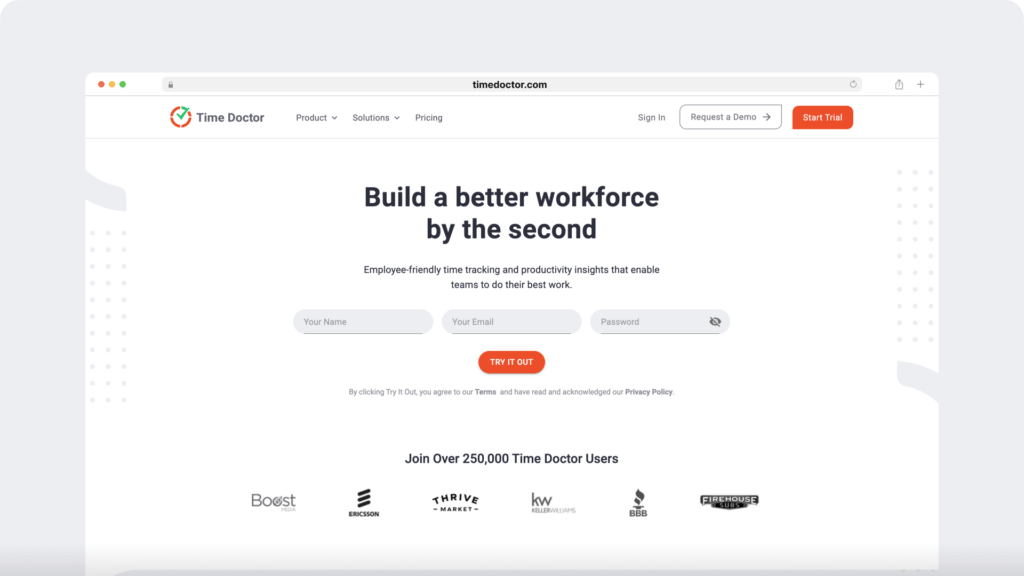Ever since COVID-19 hit, there’s been a sharp rise in remote working.
And that’s resulted in tons of remote work articles and telecommuting tools popping up.
But with all this information out there, one question remains:
What does fully remote work mean?
Don’t worry, we’ll answer that in this article.
We’ll cover the various kinds of remote work, its advantages and disadvantages and even where you can find remote work. Think of this as a comprehensive guide to everything you need to know to get started with fully remote work!
This article contains:
- What is Fully Remote Work?
- Remote Work vs. Work from Home vs. Flexible Hours
- Advantages to Fully Remote Work
- Disadvantages to Fully Remote Work
- Misconceptions about Remote Work
- How to Find Fully Remote Work
- Tips and Tools for Remote Work
Let’s go.
What is fully remote work?
Fully remote work is any job or position where you don’t have to work from your company’s office. Instead, you work from somewhere else and have the flexibility to travel to other places.
For example, if your company is based in New York or London, you can work while exploring Bali or Peru. All you need to live that digital nomad lifestyle is a strong internet connection.
Alternatively, you could work while relaxing on your couch – which due to COVID-19, is what you’re stuck with for now!
If I’m a full-time remote employee, does that mean my company is too?
You can be a fully remote worker on a fully remote team (aka “distributed team”) in a fully remote company. That would mean that none of your coworkers work from the office!
In other cases, you and a few others may be full-time remote workers, but other members of the company could work at the company’s office. Alternatively, your company might offer it’s employees part-time remote work arrangements, where you get to work remotely for a specified number of days each year.
You can also be a remote freelancer or contractor that works with distributed teams or companies with no remote employees.
Where do remote workers work?
If you could work anywhere, where would it be?
It turns out that the answer to that question is probably your house!
The Buffer 2019 State of Remote Work Report found that 84% of remote workers worked primarily in their homes. 8% utilized coworking spaces as their primary place of work, and 4% reported coffee shops as the place where they do most of their work.
What’s a coworking space?
A coworking space is an office setting where remote workers and small companies can collaborate.
They are usually set up like traditional offices – giving you the feel of an office space without the hassle. If you like an office environment, you can get those same watercooler chats while keeping your independence as a remote worker.
For some, coworking spaces are pretty much the best of both worlds.
They also can be advantageous over coffee shops, because of those networking opportunities, fewer distractions and better internet connection!
Do remote workers really travel while they work?
According to that same Buffer study, 44% of remote workers said they spent one week to one month travelling and working during the year. An additional 19% reported doing so one to six months a year.
So, while most remote workers spend most of their time working at home, you do get the time to globetrot and work at the same time.

Remote work vs. work from home vs. flexible hours
Remote work, work from home, flexible hours…
Understanding all these terms can get really confusing, right?
But don’t worry!
It’s easy to understand the distinctions between remote work, work from home and flexible hours:
1. Remote work
Remote work is an umbrella term for different kinds of work done outside the company’s office. It emcompasses ideas like flexible hours and work from home, aka telecommuting.
2. Work from home
Work from home is a specific kind of remote work that involves working from home. It’s also known as telecommuting.
Sounds self-explanatory, right?
Keep in mind that this phrase usually describes people who are part-time remote workers. These are people that sometimes work in an office and sometimes work at home.
People may have “work from home days,” where they do what they’d normally do in the company’s office at home. Right now, many people around the world have adopted some variation of work from home due to the COVID-19 pandemic.
3. Flexible hours
Having the freedom to start and end your work day when you want to is known as flexible hours.
You might prefer to get your brain moving early in the morning and end your day in the early afternoon. Or, you can sleep in a little bit to work throughout the evening.
It’s about what works for you.
While flexible schedules are often a feature of remote work, not all remote work is done on flexible hours. Many fully remote companies operate over specific hours to ensure that everyone is available at the same time.
This is especially important for global teams as it ensures that there’s an overlap between remote working hours across different time zones.
4 advantages of fully remote work
There are plenty of reasons to love remote work.
After all, the freedom to travel and to skip the commute sounds pretty great, right?
But, remote work doesn’t just benefit the employees.
There are also plenty of upsides for employers, too!
Here are a few of the perks of adopting fully remote work for both employers and employees:
A. Healthier work-life balance
What would you do with the time that you save skipping the commute to the office?
You could get in some extra exercise, spend more time with your family or dedicate additional effort to your hobby.
Fully remote workers get their time back.
They’ll have more time to do what they love and focus on their personal lives.
This is going to make them happier with their job which leads to:
B. Increased productivity
Most remote employees can structure their work day, picking when and where they get to work.
This way, remote workers are often more productive than office workers and might even do better work.
Why?
They only work when they’re at peak productivity and in environments that are comfortable for them. This way, they’re not wasting their work hours and are putting in everything they can.
C. Fewer missed days
These days, workers presenting symptoms of COVID-19 need to stay home for safety reasons. Remote work gives them the flexibility to stay home and still work.
Even when there isn’t a global pandemic, a 2014 survey by PGi found that 69% of remote workers reported less absenteeism overall.
Why?
As you can work remotely, you’re less likely to take the day off when you have a mild cold or a mid-day appointment. Your flexible schedule will help you work around that without inconveniencing your coworkers!
D. Lower costs for companies
This is the one of the largest perks of remote work.
Sure, remote employees can save money by skipping the daily commute and cooking their meals themselves, but that isn’t all.
As companies will have fewer employees to accommodate in traditional offices, they’ll benefit from:
- Lower real estate costs as they don’t need as much office space
- Lower utility bills as they’re catering to fewer people
- Reduced equipment and maintenance costs
- Fewer allowances such as meal and transport compensations
This is especially beneficial for startups and small businesses, who need to utilize their available funds as efficiently as possible.

2 disadvantages of fully remote work
While remote work has many upsides, it’s not perfect.
Here are a few problems that you’d likely face with remote work:
A. Difficulty with communication
When working remotely, you need to rely on online communication tools to get in touch with your team members, especially if they’re in different time zones.
What can that result in?
Not being able to interpret body language, losing out on facial expressions and an increased chance of misunderstandings.
Emojis only go so far!
It can also get lonely if you’re used to working from an office environment with lots of other people around.
B. More distractions
When you work from home, it’s easy to get distracted.
Remember – these aren’t environments built for productivity – there’s bound to be tons of things interrupting your workflow.
Whether it’s a family member, your pet or the doorbell – there are tons of distractions you’ll have to cope with in your home office.
2 misconceptions about fully remote work
While remote working has been growing, there are still a few common misconceptions about it.
Here’s a brief look at two of them:
Myth #1: Remote workers don’t work sincerely
Since remote workers work from home, they’re busy watching Netflix all day, right?
Nope.
Remote workers do work, and they might even work harder than their office-going counterparts.
Remember, when you work remotely, you need to make your own schedule and guide yourself through tasks.
That’s going to require some serious self-discipline!
Myth #2: Fully remote workers get paid less
Since remote workers don’t have to come to office, they get paid less, right?
Not necessarily.
Your salary is usually going to be determined by your skillset and prior experience. The work setup you’re in isn’t as important as those two factors.
In fact, that study by Buffer found that 19% of remote workers earned $75,001-$100,000. And, even better, 30% earned $100,001-$200,000!
How to find fully remote work
Once you’re convinced that fully remote work might be a good choice for you, you might ask:
“How do I even find a fully remote position?”
Well, there are a few places to start:
Step 1: Find jobs that can be done remotely
Is your job a good fit for remote work?
While there are many different kinds of telecommuting jobs out there, not every position can be done remotely.
Common positions with remote workers include:
- Software development
- Marketing
- Customer service
- Accounting
- Administrative services
- Sales
- Data analysis
- Quality assurance (QA)
- Social media management
If your job fits into one of these fields, you shouldn’t have any trouble finding potential positions!
Step 2: Look for remote jobs
You now know that your job can be done remotely.
Great!
But where do you find the opportunities for remote work?
Here’s how:
A. Remote job boards
One way to look for remote positions is to check job boards for remote jobs. You can have a look at job boards set up specifically for remote positions, such as:
- Flexjobs
- We Work Remotely
- Remote.co
- Workingnomads.co
- Remote Age
You can also try more traditional job sites, such as LinkedIn or Angel.co. Most offer tools for filtering job postings for remote work to help you find the perfect fit.
Don’t overlook freelancing job postings that you come across freelance platforms like Upwork and Freelancer. Freelancing can be a good way to get into a telecommuting job, even if it’s just part-time at the beginning.
B. Reaching out to companies with remote teams
You might have heard that a certain company is fully remote or has many remote teams. If that’s the case, there’s a good chance that there’s a remote position available there.
However, before approaching, always double check to make sure that they have job listings with remote positions. Even if a company has many remote employees, don’t assume all positions will be remote.

3 tips for remote work success
Irrespective of how you look at it, remote work is a big shift for anyone.
Luckily, transitioning to remote work doesn’t have to be difficult.
Here are three tips to ensure you have no trouble adapting to remote work:
A. Learn the skills you need to work remotely
Think about what skills you might need for remote work. Often remote work might require a little more than just the basic skills listed in the job description.
For example, many remote content creators need to know more than just writing. They also need to be accustomed to working with tools like Google Docs or Slack to collaborate with fellow team members.
Start familiarizing yourself with these apps or take courses on them to ensure that when the time comes, you’re an expert at using them!
B. Opt for video calls over emails and chats
You might feel lonely if you’re staring at a chat box all day.
While tools like Slack are great for communication, sometimes you need face-to-face communication to get over feelings of isolation. Hop on a call with video conferencing tools like Google Meet or Zoom to beat those blues and do a little team building.
Not only that, video calls are often more effective as you can pick up on a few cues like facial expressions and body language – resulting in less misunderstandings.
C. Use productivity tools to keep track of your time
Time management is one of the key skills you’ll need to master as a remote employee.
But don’t worry if that’s not your strength.
All you need is a remote productivity tool like Time Doctor to keep you productive.

It’ll help you:
- Check how long you’re spending on tasks
- Avoid distracting websites during work hours
- Ensure that you’re actively working on your projects
Conclusion
Fully remote work is quickly becoming one of the most attractive job setups for works around the globe. The freedom to choose when and where to work is too good to pass up!
But remember, you can’t jump into fully remote work overnight.
Instead, follow the tips we listed here and you’ll be able to easily transition to a remote position when you find an attractive job opportunity.

Liam Martin is a serial entrepreneur, co-founder of Time Doctor, Staff.com, and the Running Remote Conference, and author of the Wall Street Journal bestseller, “Running Remote.” He advocates for remote work and helps businesses optimize their remote teams.




